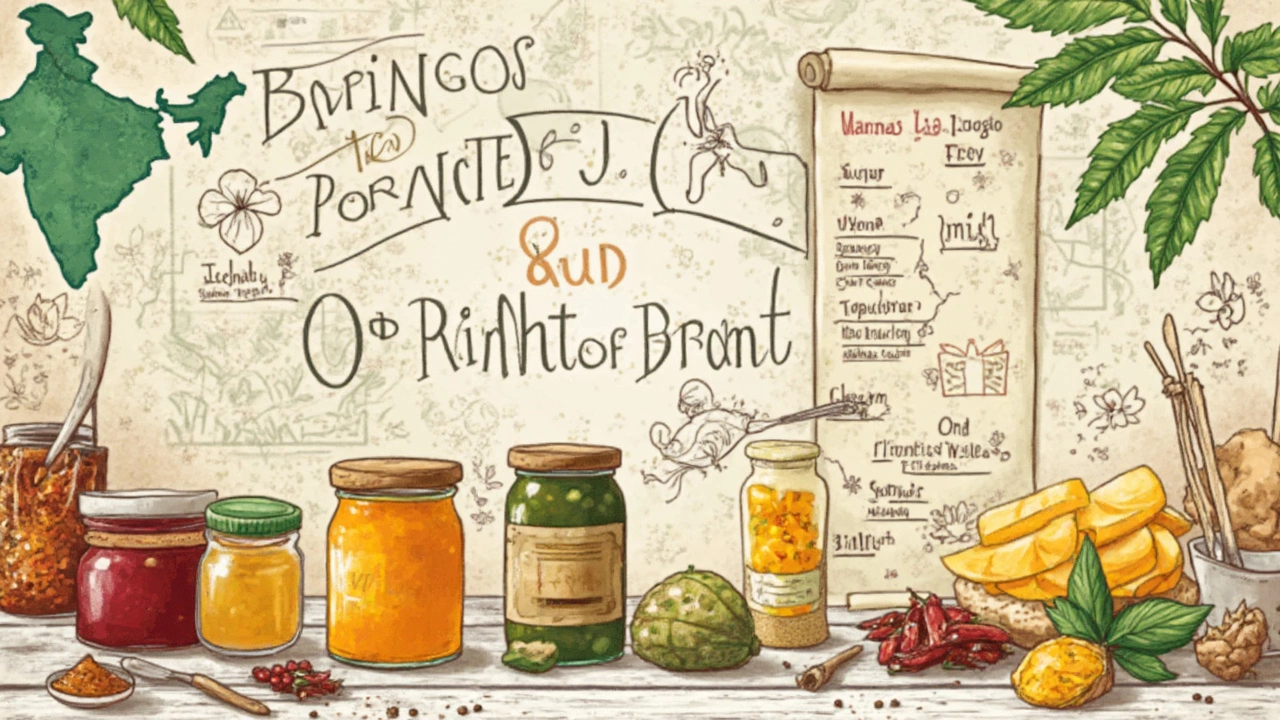2 Jul 2025
- 0 Comments
Pop into any kitchen packed with flavor-lovers, and you’ll probably find at least one jar of chutney and maybe a tub of relish sitting side by side in the fridge, looking deceptively similar. Crack them open, though, and you’ll meet a burst of personality—tang, spice, sweet, sharp, sometimes chunky, sometimes saucy. Still, ask around at a party or in a group chat: what's the difference between a chutney and a relish? Prepare for passionate rants, wild guesses, and that one friend who mutters, “I just eat what’s on the table.” These condiments have legs, stories, and real-life cultural roots, not just a place next to your samosa or hot dog.
Where Chutney and Relish Come From
The loudest truth about chutney: it’s got serious roots in India, dating back several centuries. Traditional Indian chutneys come in endless styles—herb-based, fruit-laden, spicy, tangy, raw or cooked, with or without sugar or vinegar. Imagine tamarind chutney drizzled on chaat or a spoonful of coconut chutney paired with dosa. Each region and family recipe tells a different story. Some even claim the word “chutney” is derived from the Hindi word “chatni,” which means to lick, savor, or taste. Kind of fitting for something designed to wake up your palate.
Relish, on the other hand, made its mark in Europe before finding fame in North America. Early recipes popped up in England in the 18th century, but American-style pickle relish—think the green stuff on your hot dog—really took off in the 19th and 20th centuries. Relish is all about chopped vegetables, vinegar, and sugar, cooked until flavors marry but pieces stay distinct. Unlike chutney, which got swept up in the British Empire’s love affair with exotic preserves, relish’s story is a bit more workaday—garden gluts, harvests, and the need to stretch summer’s bounty into the colder months.
There’s an unmistakable overlap, especially when you consider British-style chutneys, which evolved as a sweet-and-sour preserve, usually smoother than their Indian cousins, and sometimes looking suspiciously like what some Americans call a relish. The colonial dance between sweet, sour, tangy, and spicy flavors in both opened up doors to fusion cooking long before the word “fusion” was trendy.
Ingredients, Textures, and Core Differences
This is where things get fun—and a little spicy. Pick up a jar of authentic Indian chutney, and you might find anything from mint, coriander, green chilies, coconut, garlic, or mango as its hero. Sweetness can come from jaggery or fruit. Vinegar may appear in Anglo-Indian or Western versions, while acetic acid is less common in the oldest Indian recipes, which often rely on citrus, tamarind, or just salt for tang.
Relish wears a different badge: crunch. Think cucumber, peppers, onions—veggies chopped, cooked, and suspended in vinegar and sugar, sometimes with mustard seed, sometimes with celery seed for a pop of flavor. Sweet pickle relishes in the U.S. almost always have cucumbers, while corn or tomato relishes skirt the edges of salsa territory.
The biggest tell? Chutney is usually more of a sauce or spread, with a softer, sometimes jammy or pulpy texture—though not always smooth. Relish clamps onto a chunkier vibe, an almost salad-like distribution of crisp veggies you can see and bite through separately. Acid is another marker: Relish leans into vinegar, a holdover from its canning and preserving traditions. Sweetness is more pronounced in many Western chutneys, thanks to the British taste for sugars married with fruit and spice, while indigenous Indian chutneys often keep it subtle or bring the heat. Spice levels go wild in chutney—fiery, mild, herbal or complex with toasty spices. Relish tends to set its needle on mild, letting the brine and tang do the talking.
Grab any store-bought jar and scan the ingredients. Chutney will almost certainly have some kind of fruit (mango and apple are regulars), maybe onions, ginger, sugar, maybe raisins, and a blend of spices, plus vinegar if British-style. Relish? Look for diced cucumbers, bell peppers, onions, vinegar, sugar, mustard, quinoa, mustard seed, or turmeric.

Taste, Pairings, and Kitchen Use
Now comes the fun part: how these jars transform a meal. Chutney’s got the wide-angle lens here. Its ability to bridge sweet, sour, and spicy—sometimes all at once—makes it at home with cheese platters, sandwiches, roasted meats, curries, lentils, even French fries. Mango chutney famously elevates a humble curry, and tomato chutney snuggles perfectly next to grilled cheese.
Traditional Indian chutneys? They’re often made fresh—think coriander, mint, tamarind, coconut, tomato—each meant to wake up simple lentil dishes, fried snacks, or flatbreads. Street food and chaat practically require a thwack of tangy chutney, whether it’s cilantro-mint for brightness, or tamarind for sweet-sour punch. You’ll find that chutney offers more room to layer flavors—spices like cumin, black mustard, asafoetida, or nigella seeds mingle with fruit and veg and don’t shy away from heat.
Relish, on the flip side, plays sidekick to grilled sausages, burgers, and hot dogs—places where crunch, tang, and bite take the lead, and you want distinct little veggie pieces with every bite. The classic American green relish? It’s built to balance the fat in a juicy frankfurter, not steal the show. Corn relish works wonders with barbecued chicken, while tomato relish finds a home with fried fish or even slathered on a sandwich for extra zing. British piccalilli—a kind of mustard-forward chunky relish—pairs up especially well with cold cuts and pork pies.
One interesting thing: Chutneys actually preserve food, but they also help digestion in the traditional Indian meal context. Relishes, while originally a preserving technique, are all about stretching produce and celebrating harvest abundance, not so much medicinal effect. Both add color and brightness, but chutney veers toward festive, while relish is all about functional fun.
How to Make Chutney and Relish: Tips from the Pros
Home cooks, good news—it’s way easier than you think to make both at home, and you probably already have everything you need. For a basic fruit chutney, all you need is a base fruit (mango, apple, pineapple), onion, vinegar, sugar, salt, and your favorite spices. Toss everything in a saucepan, let it bubble until thick and jammy, and you’re done. Want more nuance? Toast your spices first: mustard, cumin, coriander, even a pinch of chili flakes or fresh ginger for kick. Don’t over-puree unless that’s the texture you love—chunky keeps things interesting.
Relish is all about the chop—the smaller and more even your veggie pieces, the better the texture. The process is simple: Dice your cucumbers, onions, and peppers as tiny as you can; salt them well and let them drain for an hour (this keeps your relish from going watery). Rinse, then simmer with vinegar, sugar, and spices you like—celery seed, mustard, turmeric, maybe chili flakes for a modern twist. Some recipes use a pinch of flour or corn starch to thicken if you want a saucier scoop. Canning ensures shelf-life, but for the instant-gratification crowd, even a basic fridge relish gets better after resting for a day or two.
Veteran canners swear by tasting as you go—start conservative with sugar and spice, and adjust up bit by bit. Acidic vinegar is key for both food safety and signature zing in relishes, so don’t skimp. If you want a chutney with a real punch, try adding a splash of citrus juice at the end, or fresh ginger for contrast. For relishes, a little diced jalapeño marries heat to the familiar tang—perfect for tacos, burgers, or veggie sandwiches.
Nervous about making a mistake? Don’t be. Both chutney and relish thrive on improvisation. Mango not ripe? Try pineapple. No onions? Use shallots. Relish swaps can be even wilder—green tomatoes for cucumbers, or add jalapeños and you’re halfway to a salsa. The idea is to preserve, not stress.

Fun Facts and Curiosities: Chutney and Relish Around the World
Believe it or not, the British Empire’s craze for chutney hit such a fever pitch that companies like Crosse & Blackwell and Major Grey (an actual brand, not a real person) started exporting “Major Grey’s Chutney” worldwide—a sweet, mild, raisin-apple-mango version that’s still a staple in British pantries, despite being pretty different from anything you’d find in an Indian home.
In the US, during the Great Depression, relish became a hero for home gardeners—turning backyard cucumbers and corn into pantry gold when times were tight. By the mid-20th century, relish had secured its spot in every baseball stadium and backyard barbecue, with more people probably eating it on the Fourth of July than ketchup. Meanwhile, in South Africa, a spicy tomato and onion relish called “smoor” acts as the essential glue of many braais (barbecues).
Other cultures make their own spin: Caribbean “pepper sauces” often blend the worlds of chutney and relish with hot peppers, fruit, and acidity. In Indonesia and Malaysia, the word “sambal” covers a dizzying range of spicy relishes, some thick, some chunky, some smooth—but always ready to wake up rice and noodles. Even Germany gets in on the fun with “zwiebel-schmaltz,” a kind of onion preserve that blurs the line between chutney and relish, eaten on bread or with pork.
Indian home cooks sometimes make more than a dozen chutney varieties for a single festival meal. No two are quite the same, and they’re meant to celebrate whatever’s in season—mango, mint, tomato, coconut, or even roasted peanuts. In American home canning culture, relish is a rite of summer, with recipes handed down like family heirlooms—grandma’s secret blend of spices, or that one amazing pepper added for a little family rebellion.
What about health? Traditional Indian chutneys used fresh herbs and spices with antimicrobial properties—cilantro, ginger, garlic, tamarind, and lime—for taste and a tiny boost to immunity and digestion. The vinegar and sugar in modern chutneys and relishes are old-school preservatives, but you can always dial down the sugar if you like. Hint: Apple cider vinegar works great for both chutney and relish, especially if you want a fruit-forward flavor and the probiotic benefits some fans swear by.
Feeling creative? Next time you make a cheese board, skip the standard grape jelly and reach for a spiced apple or tomato chutney instead—watch people light up. Or, swap out boring mayo on a turkey sandwich for a tangy corn relish or jalapeño-onion relish. You might just win over some lifelong converts.
The next time you reach into your fridge for a bold, tangy burst of flavor—whether it’s chutney or relish—you’ll know exactly what’s in your jar, how to use it, and maybe even how to make your own twist. Go on, taste the difference.
